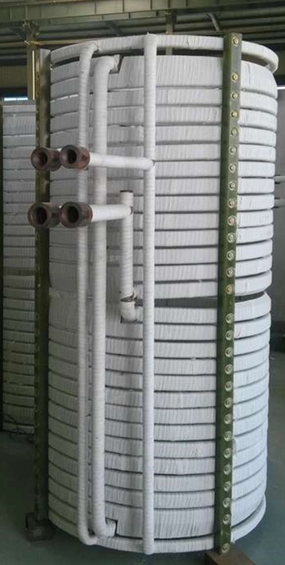- 27
- Apr
How is the inductor of an induction melting furnace made?
How is the inductor of an induction melting furnace made?
The inductor of the induction melting furnace, commonly known as the heating coil, is the load of the induction melting furnace and the core component of the induction melting furnace. It generates an alternating magnetic field through the variable frequency current provided by the variable frequency power supply, and generates eddy current inside the heated metal to heat itself. Non-contact, non-polluting heating method, therefore, induction furnace is promoted as an environmentally friendly and energy-saving electric furnace. So, what are the structure, characteristics and performance indicators of the inductor of the induction melting furnace? The electromechanical editor will introduce the inductor of this induction melting furnace.
1. The inductor of the induction melting furnace is used together with the frequency conversion device, which belongs to the load of the frequency conversion power supply, and the two cannot be used separately.
2. The inductor of the induction melting furnace is made of rectangular copper tube wound according to a certain number of turns. Copper screws are welded on each turn of the coil, and the distance between turns is fixed by bakelite columns to ensure that the length of the entire coil remains unchanged.
3. The bakelite column support system of the induction melting furnace inductor is made of special composite materials, so that each turn of the induction melting furnace coil is firmly fixed and locked, which can eliminate the possibility of short circuit between coil turns. The coils provided by some manufacturers are simple in design and poor in rigidity. During operation, due to the action of electromagnetic force, vibration will be caused. If the coil does not have enough stiffness, this vibration force will greatly affect the life of the furnace lining. In fact, the firm and solid construction of the induction coil will greatly extend the service life of the furnace lining.
4. Before assembling the inductor of the induction melting furnace, a hydraulic test is required. That is, water or air with a pressure of 1.5 times the design pressure of the water supply is introduced into the pure copper pipe of the induction coil to check whether there is water leakage at the joint between the pure copper pipe and the pipe.
5. Thick-walled induction melting furnace coils provide more heating energy. Compared with induction coils of other cross-sections, thick-walled induction coils have a larger current-carrying cross-section, so the coil resistance is lower and more energy can be used for heating. And because the thickness of the surrounding tube wall is uniform, its strength is higher than that of the coil structure with uneven tube wall and thinner tube wall on one side. That is, our induction melting furnace coils of this construction are less prone to damage caused by arcing and expansion forces.
6. The inductor of the induction melting furnace is dipped in insulating paint. Preheat the induction coil covered with insulation layer in an electric furnace or a hot air drying box, and then dip it in organic insulating paint for 20 minutes. In the process of dipping, if there are many bubbles in the paint, the dipping time should be extended, generally three times.
7. The open space between the turns of the inductor of the induction melting furnace is conducive to the discharge of water vapor and reduces the short circuit between turns caused by the evaporation of water vapor.
8. The induction melting furnace coil is equipped with a water-cooled coil, which can prolong the life of the furnace lining. Good cooling of the lining not only provides better thermal insulation and thermal resistance properties, but also increases the life of the lining. In order to achieve this purpose, when designing the furnace body, water-cooled coils are added to the top and bottom respectively, which can not only achieve the purpose of uniform furnace lining temperature, but also reduce thermal expansion.
9. The inductor of the induction melting furnace is carried out in the hot air drying box. When the inductor of the induction melting furnace is installed, the furnace temperature should not be higher than 50 °C, and the temperature should be raised at a rate of 15 °C/h. When it reaches 100~110 °C, it should be dried for 20 hours, but it should be baked until the paint film does not stick to the hand.
10. The induction melting furnace body is equipped with knotted bodies of different shapes in different parts of the coil. There are different shapes of knots on the top and bottom of the induction coil for different applications. These knots are made of special refractory materials.
11. Some unique processes are adopted in the production of induction melting furnace rings. The induction coil is made of T2 square oxygen-free copper tube and can be used after annealing. No lengthened joints are allowed, and the wound sensor must be made through the main processes of pickling, saponification, baking, dipping, and drying. After 1.5 times the water pressure (5MPa) test of conventional pressure, it can be assembled after 300min without leakage. Both the upper and lower parts of the induction coil are provided with copper tube water cooling rings. The purpose is to make the furnace lining material uniformly heated in the axial direction and prolong the service life of the furnace lining.

